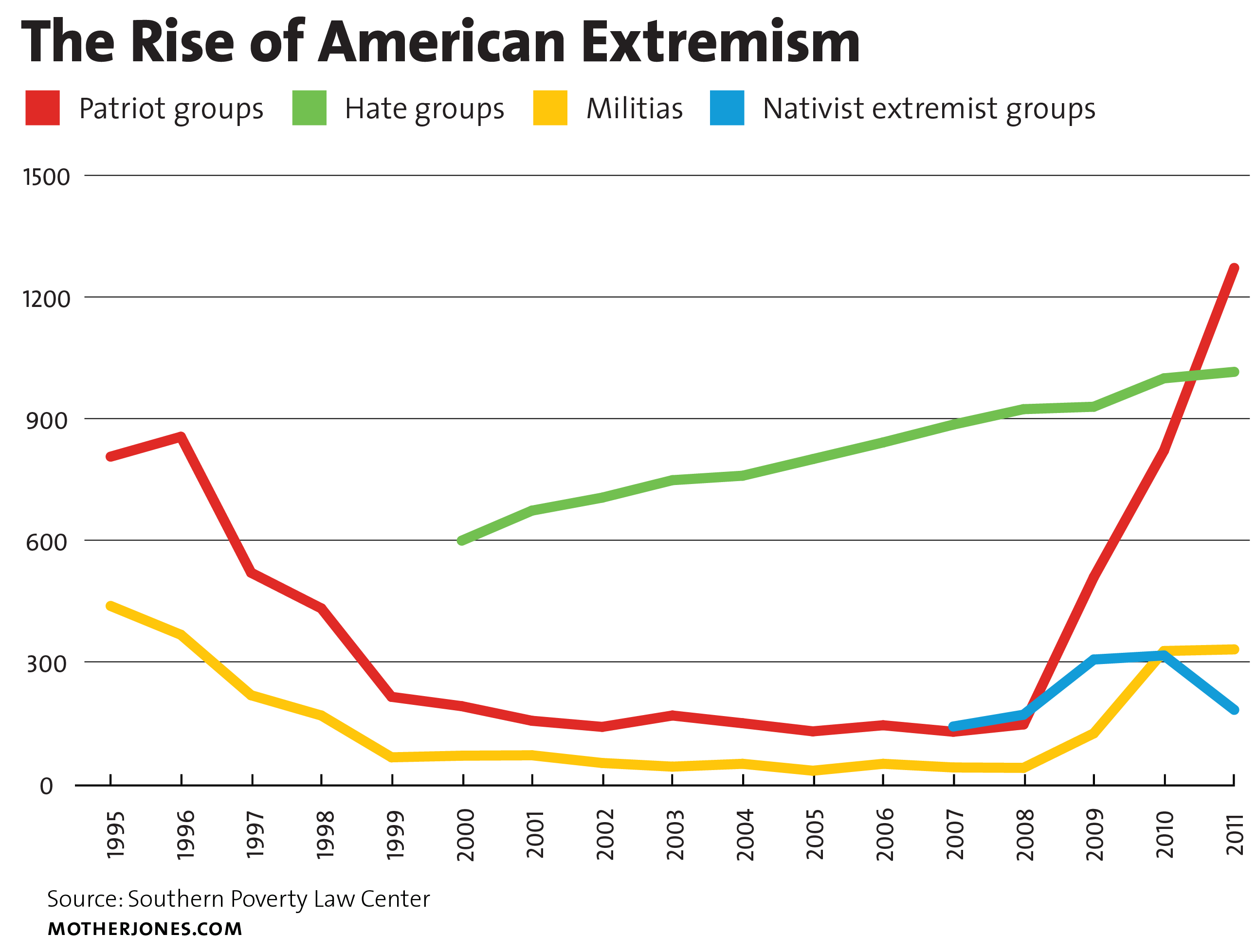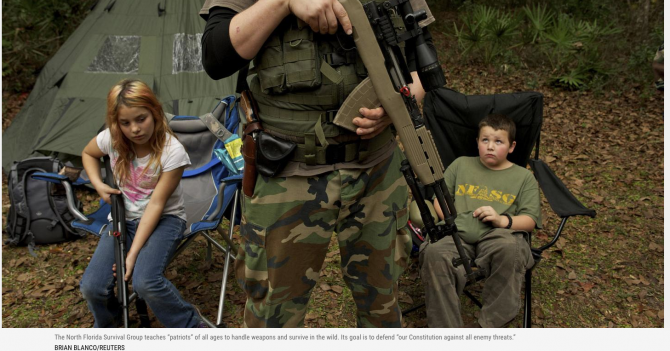The rise of far-right extremism in America is a worrisome trend and some experts blame divisive politics. These days, domestic terrorism consists of a kaleidoscope of groups with varying agendas anMd ambitions.
The data proves this.

In an informative news hour program by PBS, the United States will experience violent attacks by far right extremists every year. Why is this happening? Click here to learn more and listen to my respected colleague Peter Bergen talk about home-grown terrorism in America.
The rise of American extremism (which is unrelated to Islam) is being documented by several organizations. The data (see below) is a clear indication that the far-right is growing in the U.S. According to Bergen, “political violence comes in all shapes and forms. And I think that when we hear the word terrorism, a lot of Americans kind of think jihadi terrorism because of the 9/11 attacks but the fact is, that we continue to see extreme right wing terrorism, and we have seen a slight uptick in kind of leftist terrorism in the last couple of years.”

Many people have made the poignant point that far right extremism is classified differently. Why don’t we call far right-wing attacks an act of terrorism?
In the PBS interview, Bergen explains why: “…one of the reasons that these domestic terrorist incidents don’t get called terrorism often is because there isn’t a link to an international terrorist organization. So, as a formal matter if you are charging terrorism as a crime, if there is some link to ISIS or al Qaeda, it’s very easy to charge terrorism. Because of the First Amendment issues in this country, it’s not illegal in this country to be a neo-Nazi. It is illegal to be a neo-Nazi who carries out a violent attack. But when a neo Nazi carries out a violent attack, it’s usually simply treated as murder or sometimes as a hate crime, but not usually as terrorism from a legal point of view because there isn’t an association with an international terrorist organization such as ISIS, such as al Qaeda.”

America’s First Terrorist Attack
This past week, I gave a talk to US government officials and I gave a short list of the terrorist attacks on American soil since the early 20th century. For example, the first deadliest attack in the U.S. took place in September 1920. On Sept 16, a horse-drawn wagon with 100 lbs of dynamite stopped in front of J.P. Morgan bank during lunch hour on Wall Street in NYC and detonated. See image below of the bombing’s aftermath.
That attack killed 38 people and left many wounded. Anarchists claimed responsibility.

Then, 75 years later, a white American male named Timothy McVeigh committed a deadly attack known as the Oklahoma City bombing. Again, no Muslim involvement.
Until the rise of Al Qaeda and ISIS, which have committed savagery in the name of Islam and a fantastical cause called the Caliphate. Certainly, there have been plenty of attacks perpetrated by “non-practicing” Muslims. Add to this mix the rise of far-right extremism in America and beyond, including European countries, and we have a greater terrorism problem.
What’s Next?
Experts warn that there will be an uptick in terrorist attacks by far-right extremists. Violence will continue to haunt our liberal democracy until we seek strategic and tactical solutions to address this growing menace. In a recent chapter, I published the following conclusion.
Future Challenges
While far right extremism is nothing new, there is cause for concern. Increasingly, authorities are battling with lone actors who commit violence in the name of an ideology that denies American civil liberties and basic human rights to all its citizens and legal residents. Because far right individuals and groups operate under the radar, instead of answering to a supreme leader in a pyramid-like structure, they have been able to commit violent surprise attacks[i]—the original KKK was also a loose social network that perpetrated successful attacks. These lone actors and small networks make identification increasingly difficult.
Secondly, modern-day far right extremists also target authority figures such as local police chiefs, given their extreme antigovernment ideas and neo-Nazism, rendering the threat more volatile and vicious. Like the Klan, targeting government figures is a deadly policy designed to remove opponents from the extremists’ shared goal of an American society and polity for white Americans only.
Third, the increased use of the Internet and social media by far-right groups and individuals with neo-Nazi intentions and/or quiet support for the KKK enables far-right extremists to meet, mobilize, make plans for possible attacks, and much more. A plethora of sites, blogs, videos, and social media accounts exist that give voice to the far-right extremist movement—these sites are always shut down. So long as violent language is not used, the far right movement is allowed to use a plethora of media and online channels to spread their message and promote their vision.
As the U.S. government combats this new online threat, collaboration with the private sector could prove necessary to remove sites from individuals on Facebook or on Twitter violating terms of service of those companies, for example.[ii] Working together towards a common goal, private companies and government agencies can both monitor domestic terrorism online to fill important voids.
Finally, the rise of the far right signals more attacks.
According to the Global Terrorism Database, a program of the National Consortium for the Study of Terrorism and Responses to Terrorism at the University of Maryland, there were 65 terror attacks in 2017,[iii] and that number could increase. Terrorism experts agree that it is time to focus attention on threats from right-wing extremists and that begins with creating a designation for domestic terrorist groups, which currently does not exist.[iv] A “sober assessment of the threat and thoughtful solutions”[v] to counter domestic terrorism from far-right extremists is an important step to keeping America safe.
Endnotes
[i] Recent premeditated surprise attacks include the attack at the Tree of Life synagogue in Pittsburg (October 2018) and Dylann Roof’s attack on a Methodist Church in South Carolina. To learn more, see Jelani Cobb, “Inside the Trial of Dylann Roof,” The New Yorker, February 6, 2017 issue, available at https://www.newyorker.com/magazine/2017/02/06/inside-the-trial-of-dylann-roof; and Jelani Cobb, “From Charleston to Pittsburg, An Arc of Premeditated American Tragedy,” The New Yorker, November 1, 2018, accessed at newyorker.com
[ii] Sirwan Kajjo, “Far-Right Extremism Rising in US, Report Says,” Voice of America, November 17, 2018, accessed at https://www.voanews.com/a/far-right-extremism-rising-in-us-report-says/4663410.html
[iii] Global Terrorism Database, University of Maryland, accessed at https://www.start.umd.edu/gtd/search/Results.aspx?country=217
[iv] Jones. Also see National Public Radio All Things Considered Interview with Peter Bergen, “Right-Wing Extremists More Dangerous Than Islamic Terrorists In U.S.,” June 24, 2015, available at https://www.npr.org/2015/06/24/417192057/right-wing-extremists-more-dangerous-than-islamic-terrorists-in-u-s
[v] Jones.



